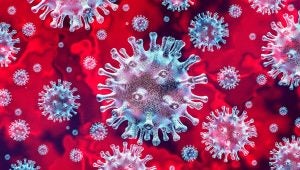Seems like all the news and views these days is skewed by the COVID-19 or politics, or a mix of the two. Since I don’t want to get into politics, I’ll keep my comments aimed at COVID, or more accurately, viruses in general. My inspiration for this article is an essay in The Economist called The Viral Universe, which explains the big impacts viruses have “on ecology and evolution as well as human health”.
When I was in college in the 1950s, professors liked to argue that viruses are not really living — they have no cell wall, no organized metabolic processes, and do not require any kind of energy source for maintenance. They might as well be a small pebble waiting to be picked up and incorporated into concrete. They are basically strings of nucleobases arranged in a specific order that contains instructions on how to make copies of itself when it comes in contact with a compatible living cell, be it a bacteria, an archaea, or any multi-celled living thing, from an ameba to a human. In other words, a virion (a single virus particle) is essentially a nearly naked gene (or genes, thinly coated with a protective layer of fat), waiting to hijack the machinery and energy of a living cell in order to selfishly use up that cell to make copies of itself.
So, if viruses are not really “living” outside of a cell, how do we “kill” them in their state of suspended animation? The answer: by using chemicals, heat, or some other method that will destroy the bonds between the nucleobases and thus disrupt the instructions. If they are inside a living cell, we depend on the immune system to break the bonds. Or we use drugs to accomplish that or to deny the virus the proteins it needs to dock with and enter a cell.

The assembled nucleobases are commonly referred to as RNA (ribonucleic acid) or DNA (deoxyribonucleic acid), which, I am sure, everyone recognizes makes up the instruction book for all life. DNA consists of a long string of nucleobases, each built around one of four amino acids — adenine, guanine, cytosine, and thymine (A,G,C,T). The order of these bases encodes the instructions for assembling proteins or other molecules the cell needs to function. RNA is also a coding molecule, but substitutes uracil (U) for thymine. DNA is double-stranded, with one strand serving as the code and the other strand as the template. RNA is generally single-stranded, and one of its main functions in a cell is to carry the code for a protein from the DNA strand (chromosome) to the ribosome, where the protein is assembled. This RNA is dubbed mRNA (messenger RNA).
Viruses come in seven classes. Three classes start out as single or double-stranded DNA, but are converted to mRNA in an infected cell. One class is double-stranded RNA and converts to single strands of mRNA in a cell. The other three classes begin as single RNA strands, with one class converting to double-stranded DNA before converting to mRNA in the infected cell. Coronaviruses, the class COVID belongs to, are the simplest, requiring no change to serve as mRNA in the cell.
The number of virions on earth easily outnumbers the trillions of stars in the observable universe. The Economist author says, “Viruses kill more living things than any other type of predator. They shape the balance of species in ecosystems ranging from those of the open ocean to that of the human bowel. They spur evolution, driving natural selection and allowing the swapping of genes …
“Viruses do not just shape the human genome through natural selection, though. They also insert themselves into it. At least a twelfth of the DNA in the human genome is derived from viruses: by some measures the total could be as high as a quarter.” Some very important evolutionary changes are thought to have been spurred by genes borrowed from viruses. The mammalian placenta forms a protective layer between cells of the mother and cells from the different genome of the fetus, yet allows for the diffusion of oxygen and sustenance to the fetus and wastes from the fetus in the other direction.The protein that allows this protective layer was originally used by retroviruses “to join the external membranes of their virions to the external membranes of cells,” allowing entry of viral RNA into the cell. (A retrovirus converts to DNA after entering a cell, and inserts itself into the DNA of the cell. HIV is an example of a retrovirus.)
In the modern era, scientists have harnessed the mechanism developed by bacteria to defend against invading viruses by chopping them up. Called CRISPR, this tool is allowing genetic engineers to cut and paste chromosomes at precise spots to edit genes or insert new ones. We have only begun to see the miracles this tool can bring to food production and medical innovations.
Jack DeWitt is a farmer-agronomist with farming experience that spans the decades since the end of horse farming to the age of GPS and precision farming. He recounts all and predicts how we can have a future world with abundant food in his book “World Food Unlimited.” A version of this article was republished from Agri-Times Northwest with permission.



